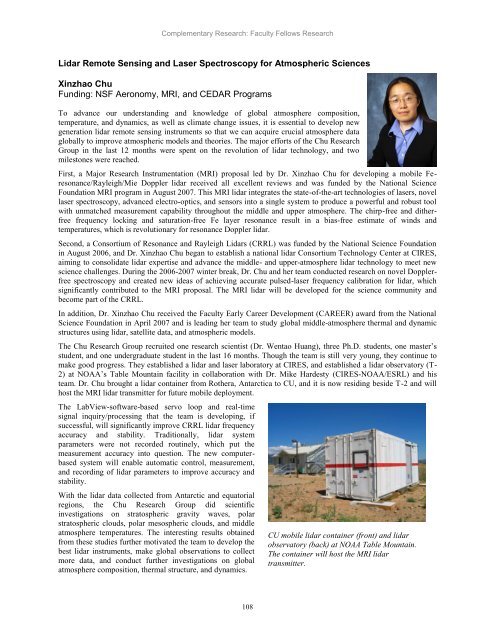Scientific Theme: Advanced Modeling and Observing Systems
Scientific Theme: Advanced Modeling and Observing Systems
Scientific Theme: Advanced Modeling and Observing Systems
You also want an ePaper? Increase the reach of your titles
YUMPU automatically turns print PDFs into web optimized ePapers that Google loves.
Complementary Research: Faculty Fellows Research<br />
Lidar Remote Sensing <strong>and</strong> Laser Spectroscopy for Atmospheric Sciences<br />
Xinzhao Chu<br />
Funding: NSF Aeronomy, MRI, <strong>and</strong> CEDAR Programs<br />
To advance our underst<strong>and</strong>ing <strong>and</strong> knowledge of global atmosphere composition,<br />
temperature, <strong>and</strong> dynamics, as well as climate change issues, it is essential to develop new<br />
generation lidar remote sensing instruments so that we can acquire crucial atmosphere data<br />
globally to improve atmospheric models <strong>and</strong> theories. The major efforts of the Chu Research<br />
Group in the last 12 months were spent on the revolution of lidar technology, <strong>and</strong> two<br />
milestones were reached.<br />
First, a Major Research Instrumentation (MRI) proposal led by Dr. Xinzhao Chu for developing a mobile Feresonance/Rayleigh/Mie<br />
Doppler lidar received all excellent reviews <strong>and</strong> was funded by the National Science<br />
Foundation MRI program in August 2007. This MRI lidar integrates the state-of-the-art technologies of lasers, novel<br />
laser spectroscopy, advanced electro-optics, <strong>and</strong> sensors into a single system to produce a powerful <strong>and</strong> robust tool<br />
with unmatched measurement capability throughout the middle <strong>and</strong> upper atmosphere. The chirp-free <strong>and</strong> ditherfree<br />
frequency locking <strong>and</strong> saturation-free Fe layer resonance result in a bias-free estimate of winds <strong>and</strong><br />
temperatures, which is revolutionary for resonance Doppler lidar.<br />
Second, a Consortium of Resonance <strong>and</strong> Rayleigh Lidars (CRRL) was funded by the National Science Foundation<br />
in August 2006, <strong>and</strong> Dr. Xinzhao Chu began to establish a national lidar Consortium Technology Center at CIRES,<br />
aiming to consolidate lidar expertise <strong>and</strong> advance the middle- <strong>and</strong> upper-atmosphere lidar technology to meet new<br />
science challenges. During the 2006-2007 winter break, Dr. Chu <strong>and</strong> her team conducted research on novel Dopplerfree<br />
spectroscopy <strong>and</strong> created new ideas of achieving accurate pulsed-laser frequency calibration for lidar, which<br />
significantly contributed to the MRI proposal. The MRI lidar will be developed for the science community <strong>and</strong><br />
become part of the CRRL.<br />
In addition, Dr. Xinzhao Chu received the Faculty Early Career Development (CAREER) award from the National<br />
Science Foundation in April 2007 <strong>and</strong> is leading her team to study global middle-atmosphere thermal <strong>and</strong> dynamic<br />
structures using lidar, satellite data, <strong>and</strong> atmospheric models.<br />
The Chu Research Group recruited one research scientist (Dr. Wentao Huang), three Ph.D. students, one master‘s<br />
student, <strong>and</strong> one undergraduate student in the last 16 months. Though the team is still very young, they continue to<br />
make good progress. They established a lidar <strong>and</strong> laser laboratory at CIRES, <strong>and</strong> established a lidar observatory (T-<br />
2) at NOAA‘s Table Mountain facility in collaboration with Dr. Mike Hardesty (CIRES-NOAA/ESRL) <strong>and</strong> his<br />
team. Dr. Chu brought a lidar container from Rothera, Antarctica to CU, <strong>and</strong> it is now residing beside T-2 <strong>and</strong> will<br />
host the MRI lidar transmitter for future mobile deployment.<br />
The LabView-software-based servo loop <strong>and</strong> real-time<br />
signal inquiry/processing that the team is developing, if<br />
successful, will significantly improve CRRL lidar frequency<br />
accuracy <strong>and</strong> stability. Traditionally, lidar system<br />
parameters were not recorded routinely, which put the<br />
measurement accuracy into question. The new computerbased<br />
system will enable automatic control, measurement,<br />
<strong>and</strong> recording of lidar parameters to improve accuracy <strong>and</strong><br />
stability.<br />
With the lidar data collected from Antarctic <strong>and</strong> equatorial<br />
regions, the Chu Research Group did scientific<br />
investigations on stratospheric gravity waves, polar<br />
stratospheric clouds, polar mesospheric clouds, <strong>and</strong> middle<br />
atmosphere temperatures. The interesting results obtained<br />
from these studies further motivated the team to develop the<br />
best lidar instruments, make global observations to collect<br />
more data, <strong>and</strong> conduct further investigations on global<br />
atmosphere composition, thermal structure, <strong>and</strong> dynamics.<br />
108<br />
CU mobile lidar container (front) <strong>and</strong> lidar<br />
observatory (back) at NOAA Table Mountain.<br />
The container will host the MRI lidar<br />
transmitter.
















